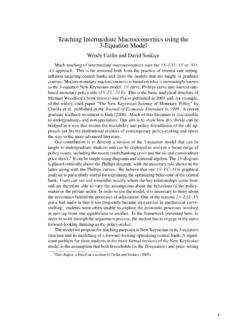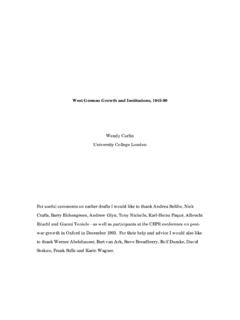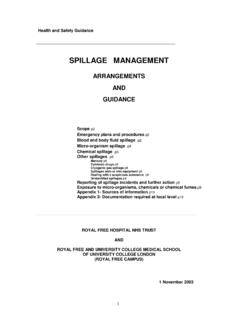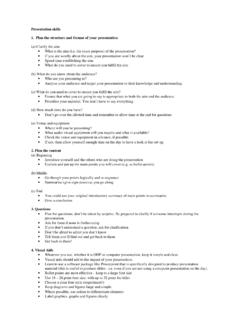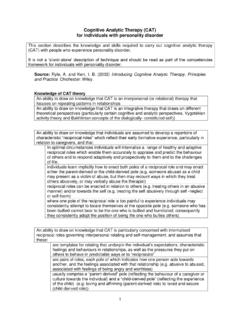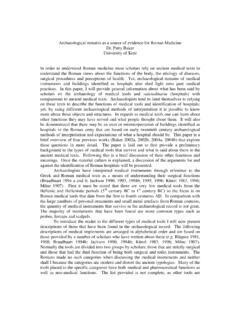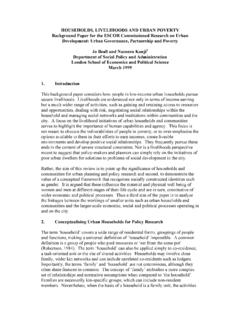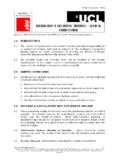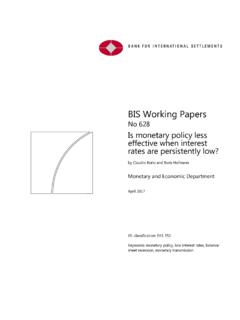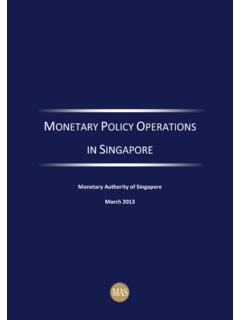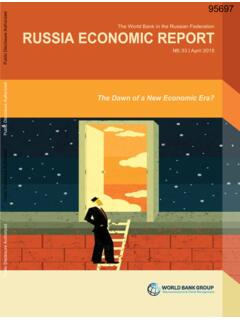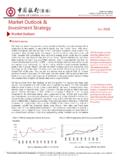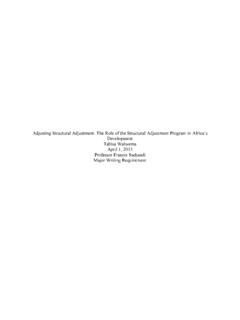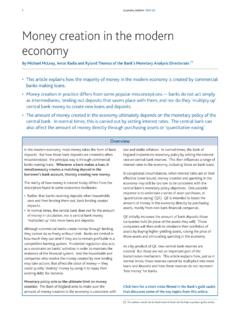Transcription of Shocks and policy responses in the open economy …
1 CHAPTER 6. Shocks and policy responses in the open economy [This is a draft chapter of a new book - Carlin & Soskice (200x)1]. In this chapter, the open economy model developed in Chapters 4 and 5 is put to work to ex- amine government policy instruments and to analyze Shocks that may disturb the economy . The term Shocks ' is used to describe a disturbance to the economy that was unanticipated. Firms and households are likely to be forward-looking and, at least to some extent, are able to incorporate anticipated changes in their economic environment into their behaviour. It is the different kinds of unanticipated changes in the economic environment on which we focus in this chapter. We use the model to analyse aggregate demand Shocks , supply Shocks and external Shocks .
2 In each case, it is necessary to diagnose the implications of the disturbance for the private sector and for policy -makers does it shift the -curve, is it a shift along the -curve, does it shift the -curve or the -curve? In order to assess the likely response of the private sector to the shock and to examine the appropriate policy response of the authorities, a diagnosis of the type of shock has to be made. Some Shocks are relatively simple to analyze in the sense that they have an impact on only one of the three relationships in the model. Others are more complex for example, shifting more than one relationship. The importance of the correct diagnosis of the type of shock is demonstrated by the experience of the advanced countries in the 1970s.
3 In 1973 and again in 1979, the world price of oil increased sharply. The consequence of the first oil shock was a fall in aggregate demand in the oil-importing OECD countries. Many countries adopted policies in response to the first oil shock based on the in- terpretation of it as an aggregate demand shock one that shifted the aggregate demand curve to the left. Yet the attempt to offset the impact of the shock on employment through fiscal expansion was accompanied by rapid deterioration in the trade balance and rising in ation. A number of European countries experienced in ation rates rising well into double digits at a time of rising unemployment. The second oil shock in 1979 was met by quite a different policy response .
4 By then it was clearer that the rise in the price of oil was an external supply shock, which had the effect of shifting the -, - and -curves in an adverse direction. Another example is the slowdown in productivity growth in the advanced countries from the early 1970s. Although the language of Shocks ' fits the case of a change in the productivity growth trend less well, it is still a useful way of conveying the idea of an unanticipated change in trend. Usually it is only with hindsight that it is possible to identify cyclical changes in aggregate demand, commodity prices or productivity growth from longer lasting movements. An interesting question in the early 21st century is whether the rise in productivity growth in the United States from the mid 1990s signals a new trend of higher productivity growth due for example to the widespread introduction of new information technologies or simply an usually long cyclical upswing.
5 The analysis of different kinds of Shocks , private sector responses and the efficacy of government policy measures also provides some of the tools that are needed in analyzing how a currency union 1. c Wendy Carlin & David Soskice (2003). We are very grateful to Andrew Glyn, Georg von Graevenitz, Massimo di Matteo, Nicholas Rau and William Wachtmeister for their help and advice but we are responsible for all errors. 1. 2 6. Shocks AND policy responses IN THE open economy . operates and the advantages and disadvantages of membership. Chapter (Interdependent Economies). on the macroeconomics of European Monetary Union explores this further. This chapter begins with an introductory section that looks at fiscal, monetary and supply-side policy in the open economy .
6 This ties together the Mundell Fleming analysis (from Chapter 4) with the medium- and long-run analysis in Chapter 5. This is followed by an examination of four different kinds of Shocks : domestic aggregate demand Shocks , domestic supply Shocks , foreign trade Shocks , and external supply Shocks . In each case, we ask what the implication of such a shock is for the short- run, the medium-run and the long-run equilibrium. This helps us to analyse what would happen after each kind of shock if the government did not react to it at all. We can then ask whether there are appropriate tools available to the government with which to offset such a shock or to mitigate its effects on the economy . There is then a summary section that draws together conclusions for the usefulness of the dif- ferent policy instruments.
7 The chapter ends with a short section that examines the implications of uctuations in aggregate demand and of supply-side policy measures for the behaviour of real wages. 1. Fiscal, monetary, exchange rate and supply-side policies The open economy model is very useful for analyzing the impact on the economy of policy changes at home and abroad as well as the impact of shifts in private sector behaviour. The key components of the model set out in Chapter 5 are: the -curve. This shows the combinations of the real exchange rate and level of output at which the goods market is in equilibrium and the real interest rate is equal to the world real interest rate. the -curve. This is defined as the combinations of the real exchange rate and output at which the wage-setting real wage is equal to the price-setting real wage.
8 At any point on the -curve, in ation is constant. the -curve. This shows the combinations of the real exchange rate and the level of output at which trade is balanced: . Timing assumptions. This is an appropriate point at which to spell out the assumptions that are being made about the speed of adjustment of different macroeconomic variables in the open economy . : The short run. In the short run, the goods market equilibrium is established and arbitrage in financial markets ensures that the home real interest rate is equal to the world real in- terest rate. In the short run, we observe changes in the nominal interest rate, the nominal exchange rate, output and The end of the short-run adjustment is marked by the attainment of the short-run equilibrium on the -curve.
9 In the short run, it is assumed that wage and price-setters do not change wages or prices. : The medium run. The medium run begins when wage and price-setters start to respond to two things: to any change in the level of activity (output, employment) in the economy that has occured in the short run and to any change in the real wage that has been brought about by a change in the nominal (and hence the real) exchange rate in the short run. : Wage-setting is assumed to happen periodically and price-setters are assumed to adjust their prices rapidly in the wake of wage changes. This means that the actual real wage in the economy is always equal to the price-setting real The end of the medium run is 2By virtue of any change in the exchange rate, the consumer price index changes.
10 Although this will in uence the short-run equilibrium in the money market, this effect is normally ignored. 3. This is obviously a simplification if price-setting is sluggish in the wake of cost increases, then the real wage will lie between the wage-setting real wage and the price-setting real wage ( between the -curve and the -curve). 1. FISCAL, MONETARY, EXCHANGE RATE AND SUPPLY-SIDE POLICIES 3. marked by the attainment of the medium-run equilibrium with the economy at the intersec- tion of the -curve and the -curve, and hence with constant in ation. : The long run. In the long run, the presence of a current account surplus or deficit may produce shifts in the -curve (as consumers react to the changes in wealth implied, or the government adjusts fiscal policy in response to market or political pressures).
